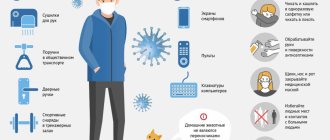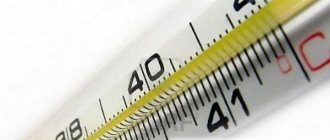For respiratory infections, you just need to sit at home for a few days, rest, drink hot tea or milk with honey. If your body temperature is elevated, take an antipyretic drug and that’s it – recovery is just around the corner. This is what most of us thought just recently. The COVID-19 pandemic forced us to remember that less than a hundred years ago, influenza epidemics killed tens of millions of people. Nowadays humanity is more attentive to the manifestations of ARVI. But there are still many who do not pay enough attention to colds and flu, preferring to carry the infection on their feet and not take any measures for treatment. In many cases, such carelessness can lead, if not to death, then to the development of complications that are not so easy to cope with. According to doctors, colds are especially dangerous for those who already have chronic diseases, as well as for children and the elderly.
- Symptoms of a cold in adults The first signs of a cold in children
- Myth 1. The cause of colds is cold weather, wind and hypothermia
It can be assumed that ARVIs have been companions of humanity since its very appearance. It is quite possible that Neanderthals who lived in caves also sneezed, coughed and experienced the same unpleasant symptoms as our contemporaries when they had a cold. Colds and flu were first mentioned in chronicles dating back to 412 BC. The healer Hippocrates was the first to tell the world about an insidious disease that manifests itself as pain in the head, throat and whole body.
Also in the chronicles there is a mention of high body temperature - probably in those years they were already able to identify such a symptom as fever. And Hippocrates was especially concerned about the extreme contagiousness of this infection. If one person in a community fell ill, others immediately became infected. Thus, epidemics developed that covered a huge number of people. It is not known what the mortality rate from ARVI was in those days, but it can be assumed that it was high, given that modern medicine developed relatively recently, in the 19th and 20th centuries.
As follows from further chronicles, Hippocrates and his physician followers failed to cope with this disease, i.e. They did not find any drugs that would prevent one from becoming infected through contact with an infected person. And today, despite the progress and rapid development of medicine, today there are no drugs in a modern pharmacy that 100% protect a person from ARVI.
At the moment, the medical and scientific communities have comprehensively studied the known strains of the influenza virus, and have also established how a person becomes infected and what happens to the cells of the body during the development of the infection. Vaccines are invented, dozens of different drugs appear every year aimed at relieving unpleasant symptoms, but viruses always turn out to be faster. Their spontaneous mutations allow them to survive in any conditions and often escape the influence of drugs, especially narrowly targeted ones. So far, it is not humanity that is winning this race, but viruses.i
But there has still been some success in the fight against viral diseases, including ARVI and influenza. We are talking about antiviral drugs with high non-selective viral activity, which can fight not a specific strain, but all of them at once. We'll tell you about them later.
How does infection occur?
People become infected through airborne droplets or household contact. The virus is easily transmitted from a sick person to a healthy person along with particles of saliva, mucus, and sputum. When you cough or sneeze, a huge amount of infection is immediately released into the air. Viruses are released into the environment even during normal talking and breathing. In aerosol form, they can remain in the air for several minutes, dispersing 2-3 meters. Viruses settle on household items, furniture, dishes, and children's toys.
After the onset of the disease, the patient actively releases the infection into the environment. Its concentration in exhaled air decreases significantly on days 5-7. After a week, a person can be considered non-infectious.
If the patient follows simple rules, the amount of infection released is reduced by 10-70 times:
- when coughing, covers the mouth with a thick cloth;
- sneezes with his mouth closed;
- washes hands frequently with soap.
How does the temperature rise and how long does it last for the flu?
The infection begins acutely with an increase in temperature. The patient feels chills. This is the contraction of small fibers of skeletal muscles, “producing” heat. Pyrogens act on the brain, causing a subjective feeling of cold. A person who is just getting sick with the flu is trying to warm up. Peripheral vessels narrow to reduce heat transfer. The patient notices how his hands and feet become cold.
When the temperature reaches high values, the vessels begin to expand. The chills stop and the person feels “hot.” His face turns red and sweating increases (this is the so-called “red” hyperthermia). In most patients with influenza, the fever stops at 38-39 degrees, there are no pronounced disturbances in thermoregulation. When answering the question of how long the flu fever usually lasts in such cases, infectious disease specialists point to an interval of 2 to 5 days.
On days 2-4, a cough develops, which signals that the trachea has been infected by the virus. If the immune system is weak, a secondary infection may occur. In this case, the temperature will last longer.
In more severe cases, the temperature rises to 39-40 °C within several hours. Disturbances in thermoregulation occur when, even against the background of fever, the body continues to “think” that it is cold, and heat production begins to significantly dominate over heat transfer. The arteries remain in a narrowed state, and overheating (“white” hyperthermia) develops. In addition, the influenza virus also affects the vascular walls, disrupting microcirculation, which primarily affects the brain. This condition poses a threat to the life and health of the patient and requires immediate hospitalization. It is difficult to predict how long the flu with such symptoms will last, and how long the fever will persist.
What viruses infect the body
In most patients, laboratory diagnostics reveal infection with several viruses at once - the so-called mixed infection. In this case, viruses:
- change quickly, adapting to the environment;
- they develop resistance to drugs;
- They are highly contagious, meaning colds are very contagious.
The virus enters the body through the respiratory system and settles on the mucous membranes of the nasopharynx and lower respiratory tract.
Here are the 8 most common types of viruses that cause colds in adults and children:
- flu;
- rhinoviruses;
- coronaviruses;
- parainfluenza;
- respiratory syncytial;
- metapneumoviruses;
- enteroviruses;
- adenoviruses.
How to distinguish the flu from a cold
Influenza and cold viruses belong to the same group of infectious diseases (ARVI), but it is still possible to distinguish them, although sometimes not so easy. The flu is characterized by a sudden onset, the appearance of a dry, hacking cough and an increase in body temperature, sometimes even up to 40 0C. Almost immediately, this infection causes chills, muscle pain, and headaches. The nose may be stuffy, but there may not be a runny nose at the first stage.
You are concerned about loss of strength, and possible disturbances in the functioning of the gastrointestinal tract in the form of nausea, vomiting and diarrhea. Similar symptoms of a respiratory infection can be observed in both adults and children. The symptoms of a cold are most often not so “powerful”.
Causes
The main cause of the disease is infection with one or more viruses. Up to 95% of cases of viral infections in Russia are caused by ARVI. The same person can get colds 4-6 times in a year. This high frequency is explained by:
- the body's natural susceptibility to viruses;
- unstable immune response;
- lack of cross immunity;
- a large number of types of viruses;
- high speed of their spread.
The body's overall resistance to infections decreases, so a patient may get sick on average once every 1-2 months during the cold season (autumn-spring).
Cold on the lips
- The causative agent is herpes simplex virus type I.
- Infection - through airborne droplets, through a handshake, touching common objects, kissing.
- The reason is weakened immunity.
- Symptoms are itching, burning, tingling, and later - rashes in the form of blisters on the lips, mucous membranes of the nose and mouth, ulceration with subsequent formation of crusts.
- Treatment - external (ointments, creams) antiviral drugs and medications that promote rapid tissue regeneration.
- Prevention - strengthening the immune system.
High temperature in a child
Child's temperature
The child will not say that he has a high temperature. Even relatively older children, including students in elementary school, as a rule, cannot correctly assess their well-being. Therefore, parents need to closely monitor the child’s condition. You can suspect an increase in temperature based on the following signs:
- the child becomes unexpectedly lethargic or, conversely, restless and capricious;
- he is tormented by thirst (he asks for a drink all the time);
- mucous membranes become dry (dry lips, tongue);
- bright blush or, conversely, unusual pallor;
- eyes become red or shiny;
- the child is sweating;
- pulse and breathing increase. The normal heart rate is 100-130 beats per minute while sleeping and 140-160 while awake. By two years, the frequency decreases to 100-140 beats per minute. The normal breathing rate also depends on age; for a two-month-old child it is 35-48 breaths per minute, for an age from one to three 28-35 breaths.
You can measure body temperature in the armpit or groin cavity with a mercury thermometer (it most accurately shows the temperature), rectally - only with an electronic one. It is possible to measure the temperature rectally only in a small child (up to 4-5 months); older children resist the procedure, as it is unpleasant. To measure the temperature rectally, the tip of the thermometer is lubricated with baby cream, the child’s legs rise, as if washing. The tip of the thermometer is inserted into the rectum to a depth of 2 cm.
We should not forget that in children under one year of age, a normal temperature is considered to be a temperature of up to 37.5°C, and even up to 3 years of age, such a temperature does not always mean that the child is sick. You cannot measure the temperature when the child is very worried, crying, or is tightly wrapped up - the temperature in these cases will be expected to be higher. A hot bath or too high a room temperature can also increase your body temperature.
In young children, the temperature can rise up to 38.3°C for reasons unrelated to illness, such as:
- overheating (due to excessive wrapping, exposure to direct sunlight or poor drinking habits), especially before the age of 3 months;
- scream;
- constipation (if the child pushes, the temperature may rise);
- teething (one of the most common causes).
If it does not seem that the temperature is caused by one of these reasons, it persists and does not subside, or, moreover, increases, it is necessary to urgently consult a doctor. If the temperature is above 38°C, you should consult a doctor in any case.
Risk factors
A cold in an adult patient can occur at any age. Children and people with weakened immune systems are most often affected. Let's highlight the main risk factors:
- age up to 14 and from 50 years;
- bronchial asthma;
- chronic pathologies of the respiratory system;
- heart disease;
- diabetes;
- chronic infectious diseases (HIV, tuberculosis);
- renal, liver failure;
- in women - pregnancy (II, III trimesters).
When a fever becomes dangerous
An increase in temperature in itself can pose a health hazard depending on individual characteristics. Thus, patients of any age with organic lesions of the central nervous system (trauma, tumors, vascular changes, consequences of perinatal pathology) can be very sensitive to the adverse effects of hyperthermia.
An increase in temperature increases metabolism in all tissues, including the brain. Nerve cells need more oxygen, and virus-affected or narrowed vessels cannot meet their needs. In addition, against the background of fever, the production of cerebrospinal fluid may increase, and the outflow may become more difficult.
Hypoxia and compression of the brain causes severe headaches, impaired consciousness, and the appearance of convulsions. Young children with a hereditary tendency to epilepsy or a history of perinatal pathology are predisposed to the development of so-called febrile seizures - seizures occur against the background of an increase in temperature and are often accompanied by loss of consciousness.
For expectant mothers, a high temperature or one that persists for several days also poses a danger. Influenza in the early stages can provoke spontaneous termination of pregnancy; in the first trimester it causes developmental anomalies and deformities, and later – toxic damage to fetal organs and disruption of uteroplacental blood flow. Among the most common child diseases:
- heart defects;
- damage to the organs of hearing and vision;
- mental retardation;
- developmental anomalies of the skeleton, skull, anterior abdominal wall.
Answering the question whether it is possible to lower the temperature during the flu, infectious disease specialists talk about patients for whom fever is especially dangerous:
- pregnant women with fever over 38.5 °C;
- children with complaints of lethargy, weakness, a history of convulsive syndrome at a temperature of 38 °C;
- adults with poor tolerance to body temperature above 38 °C (subjectively feel a significant deterioration in their condition, suffer from severe muscle and joint pain, headaches).
Cold symptoms
Weakness and lethargy are characteristic of any cold.
Photo by cottonbro: Pexels Several hours or 1-3 days can pass between the moment of infection and the appearance of the first signs of the disease - it all depends on the patient’s immunity. Regardless of the type of virus, the disease most often occurs in an acute form.
Common signs of a cold:
- runny nose, sneezing, rhinorrhea;
- cough (can be dry, barking, paroxysmal, wet);
- dryness, sore throat, hoarseness;
- hyperemia of the pharynx (red, sore throat);
- moderate or high temperature (fever);
- pale face;
- intoxication (weakness, lethargy);
- loss of appetite;
- in some cases - conjunctivitis, lymphadenitis.
Specific symptoms of viral infectious diseases
Flu
High fever is one of the main symptoms of influenza.
Photo by Polina Tankilevitch: Pexels Various serotypes of the influenza virus mainly affect the trachea. Cough - dry, barking. The disease can be distinguished by its abrupt onset, severe intoxication due to waste products of the virus, and obvious asthenic syndrome (weakness, sweating, fatigue). Characterized by high (up to 40°C) body temperature.
Can I take antibiotics for the flu?
“Flu and acute respiratory infections are viruses, and antibiotics are directed against bacteria; they have no effect on viruses. You should take antibiotics for the flu only if you have a bacterial complication - sore throat, severe bronchitis, pneumonia. But you need to be sure that the complication is bacterial. Antibiotics for the flu will even be harmful, since they reduce immunity,” Pavel Evdokimenko, rheumatologist, academician of the Russian Academy of Medical and Technical Sciences .
At the onset of influenza, problems with the cardiovascular system are possible - moderate tachycardia, bradycardia, hypotension. Almost always, on the 1st-2nd day of illness, lung damage occurs with segmental edema, which gradually disappears within 3-5 days. Edema is diagnosed mainly only by X-ray diagnostics. However, in severe cases, acute hemorrhagic pulmonary edema is possible.
The patient may also experience:
- photophobia;
- dizziness;
- burning behind the sternum;
- pain in the eyeballs;
- abdominal discomfort;
- pain in muscles, joints.
Headaches and fever are also characteristic, which can last up to 5 days. In general, people usually get sick with the flu for 7-10 days.
How to distinguish influenza from acute respiratory infections
| Flu | acute respiratory infections |
|
|
Rhinovirus infection
The main symptom of this cold is rhinitis with intense secretion of serous-watery mucus. Watery eyes and swelling of the eyelids are also observed. The cough is dry. In an adult, the disease is much milder; it can be a cold without fever. In children, additional signs of atopic dermatitis may appear. This disease causes practically no complications.
Parainfluenza
Parainfluenza viruses mainly infect the larynx. A cold in a child most often (up to 60% of cases) goes away with manifestations of functional stenosis of the larynx due to edema (the so-called “false croup”). The disease is characterized by moderate intoxication and a rough, barking cough.
Respiratory syncytial infection
Children under 2 years of age are most susceptible to the disease. Viruses attack mainly the lower respiratory tract, which causes diffuse bronchitis with obstructive syndrome (narrowing of the bronchial lumen, whistling sounds when inhaling and exhaling). The most characteristic symptom is a dry, paroxysmal, obsessive cough. The virus also affects the nasal mucosa and the back wall of the pharynx. The disease can last a long time, with frequent relapses.
Adenovirus infection
Most often occurs in children and adolescents. Viruses spread not only in the upper respiratory tract, but also affect the intestines, lymphoid tissue, and often the organs of vision. The child may suffer from diarrhea and complain of abdominal pain due to damage to the mesenteric lymph nodes.
Adenovirus can be recognized by 4 main signs:
1. Fever.
2. Conjunctivitis.
3. Rhinitis with copious serous-mucosal discharge.
4. Granular pharyngitis (on the back wall of the throat there is a dense layer of mucus, which causes a sensation of a foreign body in the throat).
Metapneumovirus infection
It circulates all year round and in the summer season the activity practically does not weaken. Characterized by fever up to 39°C, shortness of breath, cough. In younger patients, the disease is more severe.
Enterovirus infection
The disease begins suddenly and acutely. The temperature quickly rises to 38-40°C, then drops and rises again. This wave-like course is a characteristic manifestation of the disease caused by enteroviruses. The symptoms are largely similar to those of the flu: headache, general malaise, weakness. Additionally, there may be nausea with vomiting, swelling of the face.
Coronavirus infection
Coronavirus under a microscope.
Fusion Medical Animation / Unsplash The most famous coronavirus is COVID-19. However, there are many viruses of this genus that existed long before its appearance. In most cases, coronavirus is characterized by rhinitis with profuse, watery discharge from the nose. The disease affects the lower respiratory tract, which manifests itself in severe coughing, shortness of breath, a feeling of lack of air, weakened breathing, and tachycardia. The gastrointestinal tract may also be affected. Some coronaviruses are distinguished by the absence of fever and signs of intoxication. Others (including COVID-19) provoke an increase in temperature to 39-40°C.
How to distinguish coronavirus from ARVI?
“The initial manifestations of coronavirus infection cannot be distinguished from what we see with ordinary acute respiratory viral infections. This includes fever, discomfort in the throat, and cough. General symptoms are malaise, weakness, muscle aches. But unlike ordinary acute respiratory viral infections, the new coronavirus infection is characterized by a higher incidence of shortness of breath. It can appear within a few days of the onset of the disease. Such shortness of breath is associated with damage to the lung tissue and the development of viral pneumonia. Another difference is the rapid progression of the disease. When the first symptoms appear, which are quite harmless, after 1-3 days shortness of breath may appear and the patient’s condition may worsen. And after a few more days, pneumonia may develop, sometimes requiring urgent hospitalization. And this is the main difference between coronavirus infection, which requires very close monitoring of the patient so as not to miss this beginning deterioration,” Svetlana Chikina, Ph.D., assistant at the Department of Pulmonology, First Moscow State Medical University. THEM. Sechenov .
Cold. What is important to know about her?
Common symptoms include rhinorrhea (runny nose), sneezing, and pharyngitis (sore throat). The viral infection we call a "cold" can often be treated without medication by resting, drinking plenty of fluids, and some over-the-counter medications to manage specific symptoms. There are no medications yet that are effective against the causative agents of colds.
Smoking “helps” the development of colds, including in the presence of children, since it paralyzes the ciliated cells (ciliated epithelium), which ensure the cleanliness of the respiratory tract. Colds can be spread through hands, not just through the air. To prevent the spread of viruses, do not touch your eyes, mouth and nose with your hands, and wash your hands often when you are sick or in contact with a sick person.
Some other diseases have similar symptoms to the common cold, but require immediate medical intervention and special medications. If you have a high fever (temperature above 100 degrees Fahrenheit) accompanied by chills and a cough that coughs up thick mucus, or if your cough and deep breathing cause sharp chest pain, you may have pneumonia. You should immediately consult a doctor to establish a diagnosis and begin appropriate treatment.
The safest, best, and cheapest way to treat a cold is to do almost nothing at all and let it run its course. If necessary, take medications to relieve individual symptoms.
How to treat a cold
Non-drug therapy
The best way to treat a cold without medication is to drink plenty of fluids, at least 8 to 10 glasses of soft drinks (preferably warm or hot), rest, and stop smoking. The only means that can in any way try to resist viruses are interferons (effective when used on the first - second day of illness - then useless) and CIP (Complex immunoglobulin preparation) - effective when taken simultaneously with food during the first 3 - 5 days of illness .
In case of rhinorrhea (if a stream flows from the nose), there is no need to use medications, but it is better to be patient, since with rhinorrhea, mucus drains, expelling the infection from the body, so you should not take any medications. However, if rhinorrhea lasts more than a week, then consult a doctor.
For the same reason, there is no need to treat a productive cough (when something is expelled when coughing).
If symptoms cannot be relieved using these measures, and these symptoms interfere with normal life activities, then the following safest and most effective remedies are recommended.
If your nose is blocked, especially if you can't breathe freely, use nasal drops or spray that contain oxymetazoline hydrochloride (such as AFRIN), xylometazoline hydrochloride (such as OTRIVINE NASAL SPRAY), or phenylephrine hydrochloride (such as drops or spray for nose NEO-SYNEPHRINE). But don't use them for more than three days.
If you have “congestion in the nose,” you should not use any decongestants taken orally (tablets, syrups). These medications may increase your heart rate and blood pressure. In addition, they act as a stimulant and worsen the process of falling asleep. When using a spray or nasal drops for 1 - 3 days (no more), 25 times less of the drug enters your body and, moreover, gets into the nose, that is, where it is needed, and is not distributed throughout the body, as is the case when taking the medication orally.
For fever, headaches and body aches, use aspirin or paracetamol if necessary (paracetamol is preferable in children).
Cough is a necessary evil
The lungs continually cleanse themselves to ensure efficient breathing. Normally, mucus lines the walls of the lungs and protects them from foreign particles (smoke, dust, viruses). The cilia of the ciliated epithelium push mucus with adherent particles out of the lungs. Coughing helps remove unwanted substances from the lungs more quickly.
Coughing is beneficial as long as it clears unwanted substances, such as phlegm (mucus), from the airways and lungs. This cough is called productive and often occurs with colds, bronchitis and pneumonia. On the other hand, a dry, hacking (non-productive) cough can be irritating and interfere with sleep. A cough may also be a symptom of a chronic disease such as asthma or may be caused by cigarette smoke.
A productive cough is part of the recovery process from colds and flu. Every effort should be made to remove unwanted material from the lungs by "releasing" mucus. This is the purpose of an expectorant, which thins the secretions so much that they are more easily removed by coughing (expectoration). The best expectorant is water, especially in warm liquids such as soup, which thins mucus and helps keep the airways moist. A humid environment also contributes to this. You should drink plenty of fluids and, if possible, humidify the air in your home using a humidifier or evaporating water using an evaporator. In winter, you can simply place a tray of water on the radiator. Doctors of the old school recommend, for the same purpose, the use of enzymes (mezim, panzinorm, festal) because of the pepsin they contain. Even if this is somehow incorrect from a modern scientific point of view, regarding cough, taking enzymes for colds is still useful, as it speeds up the recovery of the body, or rather the pancreas, which suffers with any cold (so-called reactive pancreatitis).
A nonproductive cough, a dry cough that does not produce phlegm, can be treated with antitussive medications. If you have a cough that interferes with your normal sleep or greatly weakens your body, you can also use one of these remedies. Single-component antitussive drugs should be used. Rest and plenty of fluids are also recommended when treating a cough. Codeine, which is found in many cough medications prescribed by doctors, is not recommended for coughing. Codeine is addictive and may cause constipation.
For a cough, if the sputum (mucus) turns greenish, yellow, or has a foul odor, if the cough is accompanied by a high fever that lasts several days, or if coughing or deep breathing causes severe chest pain or shortness of breath develops, consult a doctor. Any of these symptoms may indicate pneumonia. If you cough with blood, you should immediately consult a doctor.
Fever, headache and muscle pain The common cold is sometimes accompanied by fever, headache and muscle pain. These symptoms are best managed without medication, with rest and fluid intake, or with aspirin or paracetamol.
It is not recommended to give aspirin for a fever to a patient under 40 years of age: he may have the flu rather than a cold. People who take aspirin for the flu (or chickenpox) are at increased risk of developing Reye's syndrome. This is a fairly rare but fatal disease, the victims of which, if they survive, remain disabled for life. Contact your doctor if your body temperature rises above 39.4°C, or if a fever above 38°C lasts more than four days. In these cases, the patient apparently does not have a cold.
Seek medical help if:
- Fever with a temperature above 38.3 ° C, accompanied by chills and cough with expectoration of thick mucus (especially greenish or foul-smelling mucus)
- Sharp chest pain when taking a deep breath
- Cold-like symptoms that do not improve within seven days
- Fever with a temperature above 39.4 0C
- Hemoptysis
- Sore throat with one of the following symptoms:
- Pus (yellowish-white spots) on the tonsils or throat
- Fever with a temperature above 38.3 0C
- Enlarged or tender lymph nodes on the front of the neck
- Contact with a patient with a documented case of sore throat or diphtheria
- A rash that appears during or after pharyngitis
- A history of rheumatic fever, rheumatism of the cardiovascular system, kidney disease, chronic pulmonary disease such as emphysema or chronic bronchitis.
Why does a “lingering” cough occur?
Sometimes the above recipes “fail” - cough, malaise continues 2 or more weeks after the onset of an acute respiratory infection (cold). If this happens, you need to do tests and call a doctor.
In the vast majority of cases, this is an “attack” of a new infection on an organism weakened by a cold. These infections have different names and are treated differently. Most often, mycoplasma “attacks”; in second place are cases of “aggression” of pneumocystis. Sometimes mycoplasma and pneumocystis combine and bring the patient to a constant temperature of 37–38 degrees, severe sweating, poor sleep (coughing prevents sleep, wakes you up), weakness (asthenia).
Less commonly, a lingering cough is caused by fungi (candida) or chlamydia (usually pulmonary). Another cause of such a cough can be tuberculosis. In infants, similar phenomena can occur due to cytomegalovirus.
Any of these infections, if not properly diagnosed and treated, can greatly impair the quality of life. Bronchitis most often occurs, but pneumonia can also develop. In the USA, 40% of bronchitis in children is mycoplasma. The main warning symptom is a long-term (more than 2 weeks) persistent cough. Sometimes mycoplasma, pneumocystis, chlamydia and cytomegalovirus “stick” to children with bronchial asthma, asthmatic bronchitis - attacks become more frequent. After diagnosis and treatment of these infections, children forget about bronchial asthma for a long time.
The resistance of these microorganisms in the external environment is low - they die quickly, so the main method of infection is close household contact. People can become infected with mycoplasmosis or pneumocystis (less often chlamydia) in any “close” group - at work, at the institute, in kindergarten, at school, in the yard, in regular guests, from constantly coughing relatives.
“Candida” cough usually occurs as a consequence of excessive or improper use of antibacterial drugs, such as Biseptol, Bactrim, Septrim, ampicillin, Ampiox, etc.
In the modern economic and, therefore, social situation, tuberculosis, as a “disease of the poor,” can catch you in public transport, in a store, or at a train station. The only reassuring thing is that although there are many “infectious” people, it is quite difficult to become infected through short-term contact. It is better to start diagnosing tuberculosis at a polyclinic TB doctor or at a tuberculosis clinic at your place of residence. In difficult cases, or if you do not want to go to the dispensary, you can use the possibilities of paid diagnostics - determining bacteria using PCR or detecting the level of antibodies to Mycobacterium tuberculosis.
Diagnosis of mycoplasmosis, pneumocystosis, chlamydia, candidiasis and cytomegalovirus is quite complex - there are no signs characteristic of only “one” disease, and the microbes themselves are so small that they cannot be detected with conventional microscopy. Mycoplasmosis, pneumocystis, chlamydia, candidiasis and cytomegalovirus infection (CMV) are detected either by smears examined by DNA diagnostic methods, such as polymerase chain reaction (PCR), or by immunofluorescence (which is less reliable), or by examining blood from a vein for the presence of antibodies to these pathogens.
There are no “home” remedies for these diseases, but modern antibacterial drugs are highly effective—the cure rate reaches 95%. Prevention measures. Without studying your immune status during the cold season, you can take 2-3 courses of herbal adaptogens - ginseng, eleutherococcus. The medications are taken in the morning and during the day, and in the evening, to relieve daytime stress and improve sleep, soothing herbal decoctions are needed - valerian, motherwort.
In order not to get sick during an epidemic of viral diseases, in addition to vitamins and adaptogens, it is good to take homeopathic medicines Griphel, Antigrippin, Influcid. Getting a flu shot every year will protect you from this disease. Vaccination with influenza vaccine should be done before the onset of a flu epidemic so that immunity has time to develop. It makes no sense to get a flu vaccine in the midst of an epidemic, or when a person is already sick, since the vaccine will not protect against the disease. For people who often suffer from otitis, tonsillitis, and bronchitis, there are medications that protect against staphylococci, streptococci, Haemophilus influenzae, and Klebsiella. This is Ribomunil, Bronchomunal. It is better to entrust the selection of a prevention regimen to a doctor.
If someone in the family gets sick, the rest need to take preventive measures. It would be nice to place finely chopped or crushed garlic on saucers in your apartment. You can also put it in a pre-scalded teapot and breathe through the spout. Drink Tonzilgon or Antiseptin.
Inhalation of anti-inflammatory herbs - St. John's wort, sage, eucalyptus or propolis inhalation - can also increase the body's defenses. You can use a regular teapot as an inhaler - brew the herb with boiling water and inhale through the spout. You can use ready-made preparations - oils, solutions and tinctures - eucalyptus, propolis, fir oil, Eucabal, Doctor MOM, Bronchicum. The most convenient inhaler is the Russian ultrasonic “Monsoon”.
To prevent weakened immunity, you can use multivitamin preparations (Mul-Titabs, Unicap, Centrum and others). Yeast preparations (Yeast extract “Favorit”, Pangamin, etc.) have a good general strengthening effect. Multivitamin and yeast preparations are especially needed in the fall and spring, when the natural weakening of the immune system occurs. www.lormed.ru
What complications can a cold cause?
If you have a cold, it is important to start treatment as early as possible - this will ease the course of the disease and reduce the risk of complications:
- acute bronchitis;
- diseases of the ENT organs (sinusitis, otitis media, frontal sinusitis, sinusitis).
- acute respiratory failure
- pneumonia;
- infectious-toxic shock;
- infectious toxic encephalopathy;
- cerebral edema;
- pulmonary edema;
- respiratory toxicosis;
- acute immunosuppression;
- decompensation of chronic diseases (bronchial asthma, COPD, heart or kidney failure);
- neurological diseases (meningitis, radiculitis, neuritis).
Video 1. COVID-19 and ARVI: similarities and differences. Source: YouTube channel “Roszdravnadzor”
Diagnostics
Most often, a general practitioner makes a diagnosis based on an external examination of the patient, percussion and auscultation (listening) of the lungs. The examination is complemented by a clinical and biochemical blood test and a chest x-ray.
The virus can only be detected using one of the laboratory methods. The quickest way to obtain results is by enzyme immunoassay and immunofluorescence method. Viral antigens and antibodies to them can be detected in peripheral blood within 3-5 hours. The most modern and accurate method is the polymerase chain reaction. For diagnosis, the patient's blood, saliva or sputum is taken.
The following laboratory methods are also used:
- determination of antibodies to neuraminidase;
- compliment binding reaction;
- hemagglutination inhibition reaction;
- indirect hemagglutination reaction.
It is possible to perform pulse oximetry, spirometry, and ECG.
8 rules for dealing with a cold
1. The patient is isolated in a separate room.
If this is not possible, use a screen located at least 1 meter from the location of other people. 2. The room is ventilated, washed and disinfected as often as possible using household disinfectants.
3. The patient’s dishes are boiled and treated with a disinfectant in a separate container.
4. Linen and handkerchiefs must be boiled.
5. Any contact with a sick person is potentially dangerous, so hand washing is mandatory.
6. It is mandatory to use masks when entering a room where a patient is located.
7. Touch any household items in the patient’s room with hands wearing protective gloves.
8. If possible, the room should be disinfected using an ultraviolet lamp.
When you have a cold, you should wash your hands as often as possible. Photo: alexraths/Depositphotos
How to cure acute respiratory infections in adults
Colds can be treated with various means. But don't forget about immunity. To activate local immunity, the drug IRS ®19, containing bacterial lysates5, can be used.
IRS®19 has been used for many years in the treatment of colds, acute respiratory viral infections or acute respiratory infections. Bacterial lysates activate local immunity, thereby suppressing microorganisms on the mucous membranes of the respiratory system. It becomes harder for new viruses and bacteria to enter the body. The treatment time for colds is reduced when using IRS®194.
Cold treatment
Patients with mild to moderate disease are treated on an outpatient basis (at home). Severe clinical cases most often require hospitalization. Treatment mainly involves drug therapy.
Etiotropic (antiviral) drugs are prescribed taking into account the currently circulating strain of the virus, the age and condition of the patient. The treatment program may include medications to relieve inflammation. Antioxidants are prescribed to relieve symptoms of intoxication. For severe fever (above 38.5°C) - antipyretic medications. Basically, these are non-steroidal anti-inflammatory drugs. If complications caused by bacteria develop, antibacterial agents are prescribed.
Colds in pregnant women: what is possible and what is dangerous
| Can | Dangerous |
|
|
Video 2. Treatment of influenza, ARVI and colds: simple tips. Source: YouTube channel “Doctor Evdokimenko”
Cold medicines and prevention
When selecting drugs for ARVI, the doctor must take into account all indications and contraindications, drug interactions, pharmacological effects and age restrictions - very often a drug that is ideal for adults is not recommended to treat a child.
When choosing a drug at a pharmacy if you have cold symptoms, you should not focus only on the cost of the medicine. Very often, inexpensive drugs have a good composition, help and are beneficial, while unreasonably expensive drugs can only be aimed at combating certain strains of viruses, i.e. be selective.ii
Prevention
Vaccination is one of the most effective preventive measures against viral infection. You must also adhere to the recommendations of the Ministry of Health:
- Lead a healthy lifestyle: get plenty of sleep, spend time outdoors, get active rest, and eat a balanced diet.
- Avoid contact closer than 1 meter with sick people.
- In crowded places, use disposable masks and change them every 2-3 hours and avoid touching various surfaces with your hands.
- Regularly ventilate common areas.
- Wash your hands often with soap.
- Use disposable handkerchiefs.
- Do not touch your eyes, nose, or mouth with dirty hands.
- Rinse your nasal passages regularly with saline solutions.
Prevention of colds in adults
Prevention is easier than cure - this expression is especially true for colds. It is possible to get off the list of people who are often sick. To do this, you need to keep your immune system in good shape, and then you can calmly smile at everyone who coughs.
To prevent colds, you should follow the same therapeutic recommendations:
- Strengthen the immune system through physical exercise and hardening;
- Keep your weight normal;
- Always maintain hygiene: no one has canceled hand washing after going outside;
- Ventilate the premises as often as possible and maintain a comfortable, slightly cool temperature.
An additional remedy in maintaining immunity and protecting against colds can be a medicine - nasal spray IRS®19. The bacterial lysates included in its composition stimulate the immune system to counteract respiratory infections3,5.
Sources
- Eganyan G.A., Groppa L.G., Fazylov V.Kh., Sitnikov I.G. Treatment of ARVI and influenza in routine clinical practice // Medical news. – 2015. – No. 2. – pp. 60–61.
- Korovina N.A., Zaplatnikov A.L., Zakharova I.N. Principles of treatment of acute respiratory viral infections and influenza in children on an outpatient basis // Pediatrics. Consilium medicum. - 2010. - No. 3. — P. 40-46.
- Kupchenko A.N., Ponezheva Zh.B. Modern principles of diagnosis and treatment of ARVI // Archives of Internal Medicine. - 2021. - No. 1. — P. 6-12.
- Lvov N.I., Likhopoenko V.P. Acute respiratory diseases. Guide to Infectious Diseases. - St. Petersburg: Foliant, 2011.
- Prokhorovich E.A. Acute respiratory viral diseases // Zemsky doctor. — 2010. —№1. — pp. 39-43
How and when to lower your temperature
When dealing with fever, patients should be divided into 2 categories:
- those for whom rising temperatures pose a danger to life and health;
- all the rest are sick.
Treatment of influenza often begins on an outpatient basis: a person comes to an appointment or calls a doctor at home. An examination by a specialist allows you to assess the severity of the patient’s condition and the possibility of further progression of the disease. If the therapist (or pediatrician) decides that the patient is being treated at home, he explains what to pay attention to, how often the temperature should be measured, and what medications and non-drug medications can be used to reduce it. If a serious condition is suspected, or a rapidly developing deterioration in health, the doctor will suggest hospitalization in the infectious diseases department.
Medicines to reduce fever
According to the protocol for managing a patient with influenza, medications to combat fever are prescribed along with antiviral drugs. The selection of the drug depends on age and individual characteristics.
For adult patients, the following are primarily recommended:
- acetylsalicylic acid;
- ibuprofen;
- naproxen.
If they are insufficiently effective, an increase in neurological symptoms (severe headaches, dizziness), or disturbances in the functioning of the cardiovascular system, a second drug with an antipyretic effect is added - paracetamol or analgin. Questions about the frequency of administration and daily dosage should be discussed with your doctor. He will explain whether it is possible and necessary to lower the temperature during influenza (or ARVI) to 36 °C. Somatically healthy adult patients are recommended to take medications for hyperthermia above 38.5 °C.
Pregnant women receive treatment only under the supervision of a doctor. You should immediately consult a specialist if you have symptoms such as:
- poor tolerance to fever;
- fluctuations in blood pressure;
- abdominal pain, increased uterine tone;
- cessation or intensification of fetal movements.
The condition of children should be assessed more carefully, as they may tolerate fever less well; even in the absence of obvious neurological problems, they are more likely to experience episodes of impaired consciousness and convulsive syndrome. In addition, the ratio of body area to weight in children is greater than in adults: against the background of high temperature, dehydration begins earlier. Another criterion for the use of antipyretics in pediatric practice is the reduction or cessation of sweating in a child due to fever.
If a bacterial infection is suspected, the doctor will prescribe an antibiotic. You should not “carry out prevention” on your own.
Non-drug remedies for fever
Physical remedies can also help cope with hyperthermia. These include: drinking, temperature conditions. Here are the basic rules:
- The room temperature should not exceed 22 °C, the room should be ventilated regularly. To combat dryness, spraying water in the air and humidifiers are used.
- The patient should not be wrapped up; if the temperature drops and there is profuse sweating, the clothes are changed.
- In case of high fever, wiping with a towel soaked in warm water is acceptable. A warm shower is recommended for children. Moisture evaporates from the skin and lowers the temperature. The use of vodka, vinegar, or rubbing with a dry towel is unacceptable.
- A patient with the flu loses a lot of fluid, which leads to increased intoxication and worsening of the condition. To remove decay products, it is important to drink at least 2 liters/day. It is necessary to give preference to plain water, fruit drink, compote.
An increase in temperature during influenza helps the body localize and destroy the virus. In case of severe fever and poor tolerability of the condition, the patient needs to be prescribed drug therapy. You should immediately consult a doctor if your condition continues to worsen even with treatment.









